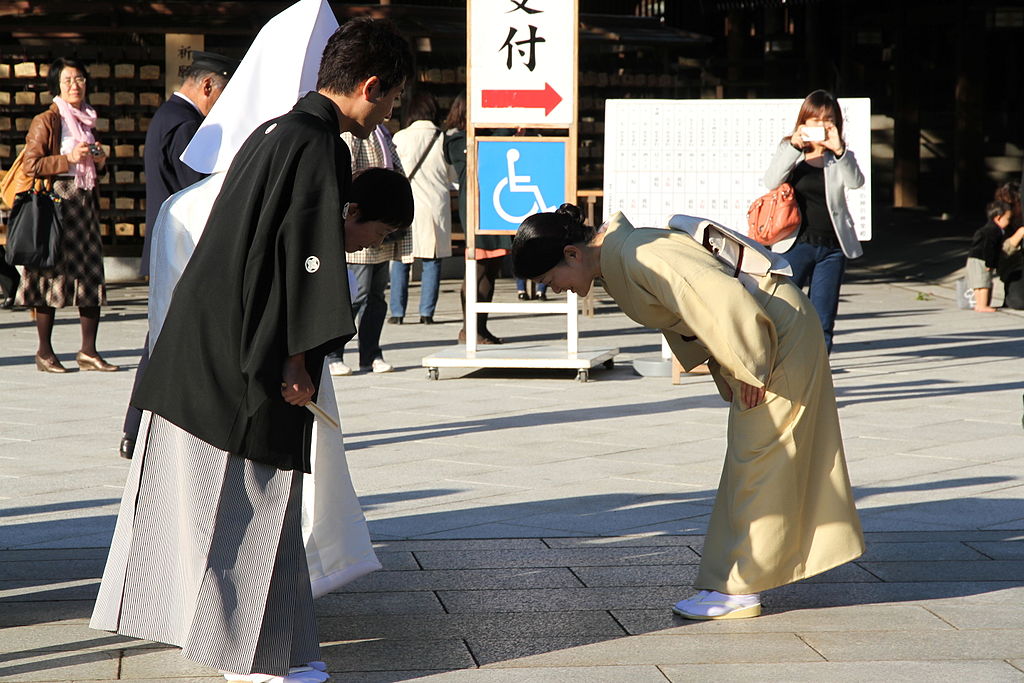From its language and religious beliefs, to the cuisine and daily social norms, Japan is a unique country steeped in tradition. It’s well known as a friendly, polite, and tolerant nation that makes everyone feel at home, but here are a few general tips on Japanese culture and etiquette if you want to make an effort to fit in like a local and avoid any common misunderstandings.
Greeting Others: Mastering the Bow
One famous element of Japanese social etiquette is the bow. This form of greeting differs from the handshake that is more common in Europe and America. Although people in Japan are familiar with the handshake, they also practice this.
Getting the bow right in Japan doesn’t take too much practice. It generally comes down to remembering how deep to bow. The general rule is to bow deep in formal settings or when meeting someone for the first time (lowering your head to around chest height), and to perform just a light nod (no lower than the neck) if greeting friends or others in more informal settings.
If you want to say something, you can opt for Konnichiwa (hello) or Hajimemashite (nice to meet you).
Be Friendly, But Don’t Get Too Close or Personal
The Japanese are known for their friendliness and politeness, but they are also reserved and generally don’t go in for big shows of emotion. Unlike, for example, parts of southern Europe, touching or getting too close to others is generally avoided – even gentle touches of the arm or pats on the back are not common. People in Japan like their personal space and it’s respectful to maintain around an arm’s length distance.
Similarly, voices are rarely raised or too animated. Body language in Japan tends to centre around the face. People smile a lot at all times and disapproval is often expressed with a gentle frown. Residents enjoy chatting about many things but tend to avoid personal topics, unless chatting with close friends. You won’t find many people opening up about their romantic life or how much they earn. Also remember that Japanese people are generally quite humble and may get embarrassed if you start showering them with compliments.
One final point (or lack of) – don’t point your finger at someone in Japan as this is seen as rude.
Dining Etiquette to Remember
Food is a very social activity in Japan, and people often have friends over for dinner or gather in restaurants to eat. As such, here are some important table manners to remember:
- Wait to be seated, and don’t start eating or drinking before others
- Use any towel/napkin provided to wipe your hands but not your face
- Most places provide chopsticks rather than knives and forks, so it’s a good idea to get used to handling them. In essence, hold both about one-third away from the ends not touching the food and operate using your thumb and first two fingers
- Slurping noodles is not seen as rude but a sign that you are enjoying your food
- If picking up food from shared dishes, use the opposite ends of the chopsticks (or separate ones if provided)
If invited to someone’s home for dinner, you will be expected to take your shoes off at the front door. Guests are often provided with slippers to wear inside.
Visiting Temples and Shrines
Family visits to Japanese temples and shrines are common at certain times of the year. Expats and tourists are also welcomed as visitors, but will be expected to follow certain customs. Temples or shrines will be either Buddhist or Shinto (Japanese religion) but they both follow similar customs in terms of visitor behaviour. You should dress modestly (cover your shoulders, chest, and legs above the knee) and remove shoes and any hats before entering any buildings. There will often be a basin near the entrance where visitors will be expected to wash their hands using a ladle provided.
You can pay your respects in front of shrines and sacred objects by saying a short prayer, offering coins (or sometimes small gifts), or burning incense (often sold at the premises). Photographs should NOT be taken inside temple buildings.
Maya-Anaïs Yataghène from Paris, France, CC BY 2.0, via Wikimedia Commons

